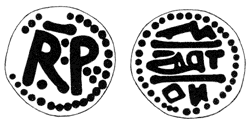- Home
- The town and the abbey
- From the royal abbey to the castellum
- The royal abbey
- A coin die trial piece
Trial piece for coin dies, second half of the 8th century.
© UASD / E. Jacquot.
Denier of Pepin struck at Saint-Denis.
© UASD / M. Wyss
The history of Saint-Denis coinage begins in the seventh century with the production of gold tremisses. These coins were minted for two locations: the Saint-Denis monastery and the vicus Catalacus, the village connected to the monastery. The coins bear the name of Ebregiselus, a coinmaker during the reign of Clovis II (639-657) and a contemporary of Eloi, another celebrated coinmaker. It was Eloi whose goldwork adorned the tomb of Saint Denis.
Around 675, the gold coin was replaced by a coin of lower value, the silver denier. The first Carolingians made efforts to reclaim the state monopoly on money production and to reduce the number of mints. Under the reign of Pepin (751-768), a minting workshop continued to operate within the monastery, as shown by this trial piece that was found in the filled-in trench of the aqueduct. The irregularly-shaped lead plate bears the impress of two coin dies, which were tested by a die-cutter before being used to mint coins. The dies correspond to a denier whose obverse bears the monogram RP (rex Pippinus) and, on the reverse, in three lines, the inscription AVT/TRA/NO. It is thought that this is an abbreviation for antistitio regio Dionusiaco ("made by the - fiat of the - royal abbey of Saint-Denis"), but this is still a matter of discussion.


